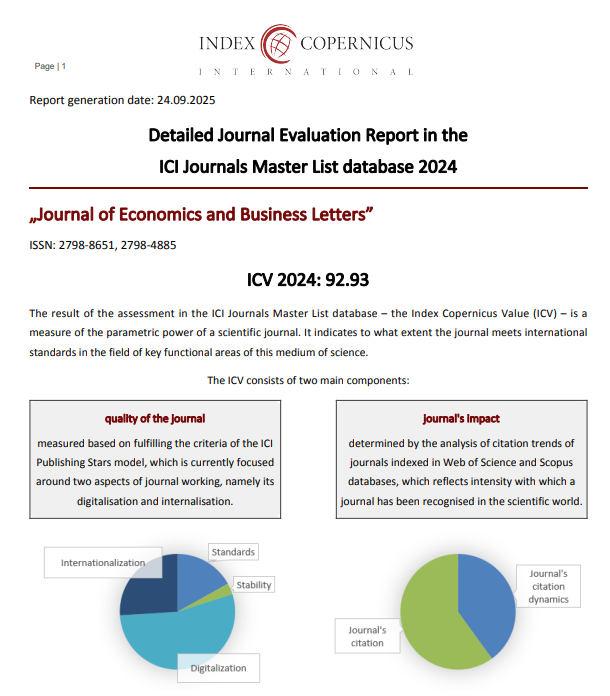Analysis of determining factors for stunting events in Petang District, Badung Regency
DOI:
https://doi.org/10.55942/jebl.v4i5.301Keywords:
Stunting, Family Income, Mother’s Double Burden, Age at First Marriage, Mother’s Education LevelAbstract
This study aims to analyze simultaneously and partially the effect of family income, maternal double burden, age at first marriage, and maternal education level on the incidence of stunting in Petang District, Badung Regency. Also, it analyzes the role of maternal education level in moderating the influence of age at first marriage on the incidence of stunting in Petang District, Badung Regency. The sample for this research was determined using the Simple Random Sampling method with a total of 60 respondents. The data collection methods used were observation, structured interviews, and in-depth interviews. Data analysis was carried out using moderated regression analysis. The results of the analysis concluded that family income, maternal double burden, age at first marriage, and maternal education level simultaneously had a significant effect on the incidence of stunting in Petang District. Family income, Age at first marriage, and maternal double burden has a negative and significant effect on the incidence of stunting in Petang District. Maternal Double Burden has a positive and significant effect on the incidence of stunting in Petang District. Maternal education acts as a pseudo-moderating variable that strengthens the influence of age at first marriage on the incidence of stunting in Petang District.
References
Amirulah, A., Aris Try, A. P., & Aris Armeth Daud, A. K. (2020). Deskripsi Status Gizi Anak Usia 3 Sampai 5 Tahun Pada Masa Covid 19. Jurnal Pendidikan Anak Usia Dini, 1(1), 16-27.
Apriluana, G., & Sandra, F. (2018). Analisis Faktor-Faktor Risiko terhadap Kejadian Stunting pada Balita (0-59 Bulan) di Negara Berkembang dan Asia Tenggara. Media Litbangkes, 28(4), 247-256.
Dinas Kesehatan Kabupaten Badung. (2022). Data jumlah balita stunting Kabupaten Badung Tahun 2022 (sumber data e-PPGBM Bulan Agustus).
Ditjen Bina Pembangunan Daerah Kementerian Dalam Negeri. (2022). Monitoring Pelaksanaan 8 Aksi Konvergensi Intervensi Penurunan Stunting Terintegrasi.
Fahlevi, M., Ahmad, M., Balbaa, M. E., Wu, T., & Aljuaid, M. (2023). The efficiency of petroleum and government health services to benefit life expectancy during the inefficiencies of hydroelectricity consumption. Environmental and Sustainability Indicators, 19, 100289.
Gladys, A., & Sandra, F. (2018). Analisis Faktor-Faktor Risiko terhadap Kejadian Stunting pada Balita (0-59 Bulan) di Negara Berkembang dan Asia Tenggara. Media Litbangkes, 28(4), 247-256.
Illahi, R. K. (2017). Hubungan Pendapatan Keluarga, Berat Lahir, dan Panjang Lahir dengan Kejadian Stunting Balita 24-59 Bulan di Bangkalan. Jurnal Manajemen Kesehatan Yayasan RS Dr. Soetomo, 3(1), 1-24.
Jain, A. K., Dsouza, S., Kayani, U., Nawaz, F., Fahlevi, M., & Aziz, A. L. (2024). Nexus of firm specific variables and capital structure decisions: an evidence from Asia Pacific region amid covid-19 crisis times. Cogent Social Sciences, 10(1), 2413619.
Januarti, L. F., & Hidayathillah, A. P. (2020). Parenting Culture on The Role of Father in Prevention of Stunting in Toddler. Babali Nursing Research, 1(2), 81-90.
Kementrian Kesehatan RI. (2018). Mengenal Stunting dan Gizi Buruk. Penyebab, Gejala, Dan Mencegah.
Larasati, D. A., Nindya, T. S., & Arief, Y. S. (2018). Hubungan antara Kehamilan Remaja dan Riwayat Pemberian ASI Dengan Kejadian Stunting pada Balita di Wilayah Kerja Puskesmas Pujon Kabupaten Malang. Amerta Nutrition, 2(4).
Marhaeni, A., & Yuliarmi, N. N. (2019). Metode Riset Jilid 1. CV. Sastra Utama.
Prasetyo, A., Noviana, N., Rosdiana, W., Anwar, M. A., Harwijayanti, B. P., & Fahlevi, M. (2023). Stunting convergence management framework through system integration based on regional service governance. Sustainability, 15(3), 1821.
Ramadhani, I. D., Latifah, L., Prasetyo, A., Khairunnisa, M., Wardhani, Y. F., Yunitawati, D., & Fahlevi, M. (2022). Infodemiology on diet and weight loss behavior before and during COVID-19 pandemic in Indonesia: Implication for public health promotion. Frontiers in Nutrition, 9, 981204.
Suyana Utama, M. (2016). Aplikasi Analisis Kuantitatif. CV. Sastra Utama.
Mugianti, S., & Mulyadi, A. (2018). Faktor Penyebab Anak Stunting Usia 25-60 Bulan di Kecamatan Sukorejo Kota Blitar. Jurnal Ners dan Kebidanan, 5(3).
Nurbaeti, T. S., & Syaputra, E. M. (2021). Pendapatan Keluarga dengan Kejadian Stunting di Masa Pandemi COVID-19: Studi Kasus Salah Satu Kecamatan di Kabupaten Indramayu. Gema Wiralodra, 12(2).
Panhardyka, T., Amalia, Y., & Herlina, S. (2022). Pengaruh Asi Ekslusif, Pengetahuan Ibu tentang Perbaikan Status Gizi, dan Pendapatan Keluarga dengn Kejadian Stunting di Desa Baturetno. Jurnal Kedokteran, 10(2).
Prayogi, I. W., & Sudibia, I. K. (2022). Analisis Faktor-Faktor yang Mempengaruhi Usia Kawin Pertama dan Fertilitas Di Kecamatan Negara Kabupaten Jembarana. E-Jurnal Ekonomi dan Bisnis Universitas Udayana, 11(9), 1025-1039.
Yuda, A., Septina, Z., Maharani, A., & Nurdiantami, Y. (2022). Tinjauan Literatur: Perkembangan Program Penanggulangan Stunting di Indonesia. Jurnal Epidemiologi Kesehatan Indonesia, 6(2).
Zouine, M., El Adnani, M. J., Salhi, S. E., & Fahlevi, M. (2024). Harnessing education to combat chronic and fatal diseases: A comprehensive empirical study of cardiovascular diseases, cancer, diabetes, and respiratory illnesses in MENA countries. Social Sciences & Humanities Open, 10, 101133.
Downloads
Published
How to Cite
Issue
Section
License
Copyright (c) 2024 Ni Komang Sukma Candra Dewi, A.A.I.N. Marhaeni

This work is licensed under a Creative Commons Attribution 4.0 International License.
















